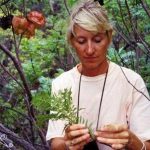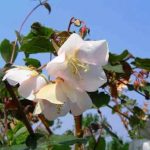TREE LIFE
JULY 1992
MASHONALAND CALENDAR
Saturday 4th July : Botanic Garden Walk. We meet at 10.45 am at the Herbarium where Tom will join us. For security reasons we may park at the Herbarium.
Sunday 19th July : Aubrey and Edone Ann Logan, and their son Rory and daughter-in-law Lynn, will host our July visit to the Shamva area at “Golden Star” and “The Range” – adjoining properties which are run as one composite farm.
If you would like a lift or have space and can offer someone else a lift, please phone Joy Killian on 308398 before Friday 17th. Because some of the terrain over which we will be walking is rough, it is advisable to wear good sensible shoes.
Saturday 25th July : No walk this month as Mark, a man of many talents, is playing the piano in a concert. ,
Saturday 1st August : Botanic Garden Walk.
MATABELELANDCALENDAR
Sunday 5th July : Back to Mguza Nature Reserve, but to a completely different Area on the quartz ridge, with beautiful views over the well treed countryside. Morning only – meet at Falls Road Motors, as it is only 15 km from Bulawayo. Bring teatime, chairs and your entrance fee — and stand by for a good morning.
Wednesday 15th July : McHEW at Hillside Dams at 5 pm
Sunday 2nd August : Keep this day free as Jeanette Schuur has suggested a gorgeous day to Regina Ruins in the Fort Rizon district – and there should be flowering aloes.
MAY – McHEW
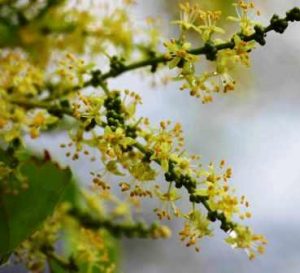
Lannea schweinfurthii. Photo: Bart Wursten. Source: Flora of Zimbabwe
On this cooler evening Ian decided to give us some guidance on how to use a botanical key in our tree identification “keying out” was the term used! We were given three different leaf specimens each with a blade, a stalk or petiole and a portion of stem from packets labelled A, B or C, Ian then asked us questions such as are the leaves simple or compound, leaves alternate or opposite etc until we had eliminated two of the three species! With the remaining specimen Ian gave us one clue and we had to guess its name. The three trees were from the EUPHORBIACEAE family being and all with similar shaped leaves but with different characteristics such as smooth or hairy leaves which hopefully, if you use your key you should be able to identify! Many thanks Ian, for yet another much appreciated lesson.
After our lesson the group discussed trees of historical interest “The Hanging Tree” Lannea schweinfurthii) was of particular interest as Joy has old photographs of the tree actually being used! “The Lookout Tree” in Suburbs is still alive. “The Baden Powell Lookout Tree” at Fort Usher on which Girl Guides placed a plaque has unfortunately died and fallen down, but the plaque can still be seen as it has now been attached to a nearby tree! It was agreed that an article on the historical trees would be of great interest and someone should be encouraged to compile one!
-PETA DITCHBURN
STUDY OF VLEIS
Mrs I.B.M. GRAVES surmised quite correctly (in Tree Life 148) that I study vleis. I would like to say I have learnt a lot, I cannot. The more I observe, the more there is to learn.
Man has had a big impact on all vleis, near to, and far from urban settlements. Sometimes, through intelligent soil and water conservation, twentieth century man has raised water tables on some vleis thus correcting centuries of gulley erosion through stream capture.
As does Benedicta, I look at the geological time scale involved, and it is sometimes possible to guess ages going back to the Gamblian, and before. I will not go into detail here because it is a very subjective study, I am however always prepared to demonstrate the known facts on the Chiraura Vlei in the Mukuvisi Woodland.
One purely subjective fact I am prepared to set down in writing is my personal conclusion that the physical fact of vleis as they are today, derives from the biological fact of the evolution of large grazing mammals and their explosive population growth in the past twenty million years.
These big grazers in effect modified their own environment, in a way which we humans are now doing, albeit in a much more destructive fashion.
Maybe the Dinosaurs also did the same and as we suspect hastened their own extinction. I regret to say I can draw no conclusions about dinosaur behaviour by looking at the Chiraurs Vlei.
-George Hall
BOTANIC GARDEN : SATURDAY 6 JUNE 1992 ,
The suggestion had been made to Tom that we would like to look at the Gymnosperms. These are the plants which produce naked seeds, not enclosed within ovaries, as opposed to the Angiosperms. As there are not many Gymnosperms in Zimbabwe, we also looked at three other groups, all Angiosperms and in fact all woody monocotyledons, namely the bamboos, palms and the Zimbabwean species of Dracena.
In Zimbabwe, the native species of Gymnosperms are found in 3 families — the PODOCARPACEAE (Podocarpus spp.), CUPRESSACEAE (i.e. Mlanje Cedar and Juniper) and ZAMIACEAE (i.e. Cycads).
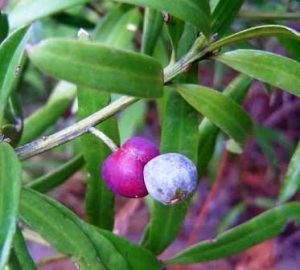
Podocarpus latifolius. Photo; Bart Wursten. Source: Flora of Zimbabwe
We were shown Podocarpus falcatus, which occurs in the Knysna Forest in the Cape, where it may attain heights of 50 m, and is also to be found on Gorongosa and in East Africa, but has never been recorded from Zimbabwe. The species which does occur in Zimbabwe, P.latifolius, was in fruit in the Gardens, showing the large red fleshy aril-like structure on which the fruit is based. P.latifolius is confined to the Eastern Districts forests in Zimbabwe and Tom mentioned that it was particularly abundant at Banti Forest Reserve and also across the border at Tsetserra in Mozambique.
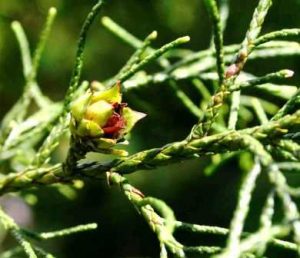
Widdringtonia nodiflora. Photo: Bart Wursten. Source: Flora of Zimbabwe
In the Eastern Districts section, we saw both Mlanje Cedar (Widdringtonia nodiflora) and the rather similar Juniperus procera. Tom explained that Widdringtonia prefers the drier type of forest, for example the rain shadow side of Mt. Nyangani, and in Zimbabwe does not achieve the size and splendour it does on Mt. Mlanje. The juvenile leaves were spreading, relatively -long and sharp tipped whereas the mature leaves were appressed, smaller and scale-like. A search for the woody cones eventually produced some old ones.
The Juniper, which is represented in Zimbabwe in the wild by one tree in-poor condition at Nyanga, showed the similar feature of different juvenile and adult foliage. It differs from the Cedar in its smaller scale—like leaves and in having fruits like a berry, though none were found on this occasion.
Towards the end of the walk we reached the Cycads. We were shown Encephalartos concinnus, an endemic of the West Nicholson and Mberengwa areas of Zimbabwe, and E.chimanimaniensis which is now very rare indeed in the Chimanimani Mountains. It seems that the high commercial value of these Cycads has hastened their decline in the wild.
On to the woody grasses to see two bamboos. Firstly, Oreobambos buchwaldii, known only in Zimbabwe from Mt Buchwa. Secondly, Oxtenanthera abyssinica, the Bindura Bamboo. The specimen in the Gardens was being smothered by the climbing Acaciapentgona which we saw on the Tree Society visit to Chirinda Forest in January.
Oxyvtenanthera prefers areas of relatively high rainfall and although flowering has been seen in wild plants (Tom mentioned specifically the Honde Valley) the specimens in the Gardens have never flowered — too cold perhaps?
Four species (and indeed four genera) of palms were seen —- two with pinnate leaves and two with palmate leaves. Not far from the Herbarium grows Raphia rafinifera, the leaves of which are pinnate and are reputedly the biggest in the plant kingdom.
Later we saw the other pinnate-leaved species Phoenix reclinata . This has a remarkable altitude range, occurring at l500m along the Dyke and at 300m at Haroni/Rusitu. It also grows well in pots and may be seen at the Harare Sheraton.
Two species with palmate leaves were Borassus aethiopum and Hyphaene petersiana, the Ilala palm. Borassus is not truly native in Tom’s opinion. The Hyphaene was formally split into two species on the basis of fruit differences, but the latest view is to unite these under one species.
The last group studied was the 3 species of Dracaena. Starting with the relatively small which is grown all over the world as a pot plant, in this country we see it as an abundant constituent of the Bunga and Chirinda Forests. D.usambarensis, formerly known D.reflexa var. nitens, has relatively small leaves and occurs as an under storey tree at Haroni/Rusitu and by streams in the Chirinda Forest which has the capacity to become a tree of a respectable size, is another frequently cultivated species. Tom mentioned that it is usually found at an altitude of 1000 m and prefers (relatively) dry forest.
Once again, we would like to thank Tom for a stimulating walk in the very lovely Botanic Gardens.
-Mark Hyde
MATABELELAND NOTES
Our return visit to the Wood’s farm — Glencurragh – Nyamandhlovu Sunday 6 June dawned cold, cloudy and windy. Undaunted, the keener (or more foolhardyl) members braved the weather for the day’s outing.
We travelled in convoy from the Falls Road garage, stopping only once to have another look at the Diospyros kirkii, in fruit, on the approach to Nyamandhlovu.
Ever hospitable, Trish and Mike treated us to a very welcome cup of tea (and banana loaf), despite our party numbering over twenty. Lead by Mike we retraced our route to the main road and a short distance back towards Bulawayo, then drove through a gate on the fence line, where Mike left us to explore the surrounding basalt area, seemingly sprouting Colophospemum mopane and Acacia nigrescens. In fact closer inspection yielded Acacia erioloba, galpinii, karroo, nilotica, mellifera and rehmanniana. We actually found it difficult to differentiate between nigrescens and mellifera in several instances. Bolusanthus speciosus, Dalbergia melanoxylon, Croton gratissimus with autumnal pink leaves, leafless Commiphora glandulosa which had to be identified by cutting a small slash to determine whether it exposed pink or green flesh, were scattered throughout the area.
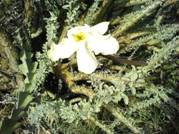
Sesamothamnus lugardii. Photo: J.P. Felu. Source: Flora of Zimbabwe
It was exciting to come upon Boscia salicifolia and foetida once again and our old friend Ormocarpum trichocarpum. As we progressed we were able to crush the seeds and enjoy the scent of Lippia oatesii. For some it was a new experience seeing Sesamothamnus lugardii and Lycium cinerium.
There was a small group of fine looking Pappea capensis and several Sclerocarya biriea.
In all we recorded some 48 species before returning to the homestead along the firebreak and through a predominantly Acacia wooded paddock. As the weather had warmed considerably we were able to eat our lunch in the garden on green lawn, a treat for us Matabelelanders.
We extend our thanks once again to Mike and Trish for opening their home to us and allowing us to tramp around the farm.
-Margaret MacCausland
JUNE McHEW
With the winter solstice less than a week away, a small group of us gathered at Hillside Dams for the mid-month McHEW at 5 p.m. on the 17th June.
Ian had done his preparation with the usual meticulousness and provided photocopies of the subject material, the Rhus. From the car park we walked a little distance to the first tree to be examined, a Rhus lancea. Discussion took place as to why its leaves are defined as having ‘margin entire‘ when dents are often noticed. However, in the absence of serration, teeth or scallops we have to accept the definition according to the book.
With the shadows lengthening and temperature dropping, we walked on towards a gully where there was congested a number of small trees and shrubs. Amazingly there are no less than three small Rhus trees of different species rubbing shoulders in that spot.
First we found Rhus leptodictya with its leaves noticeably toothed. Then there was another Rhus lancea which yours truly, the rookie, thought had fruit strangely resembling the syringa berry. Ian looked up in disbelief and we quickly established that a dead branch of a syringe tree had enmeshed itself in the branches of the Rhus, still with some berries attached and foxilly intertwined in the Rhus leaves. The mystery having been solved, we proceeded to examine the nearby Rhus pyroides, its leaves were velvety and beautiful in its winter colouration of green, orange and rust. ’
We had our American guests, Dr. Tom Raub and his wife, Mary, with us and Ian went on to explain to them about the family of the Rhus which they would be likely to find in their own country, namely the sumac family, including poison ivy (Rhus radicans) poison oak (Rhus toxicodendron) and poison sumac (Rhus vernix). They knew exactly what Ian was talking about and we hope that the Raubs will be with us for a long time to come.
With darkness encroaching we made our way back to the car park and en route spotted a huge owl as big as a cat, sitting motionless on a leafless branch. If moonrise had been a bit earlier, he’d have made a perfect traditional setting. Also just discernable in the distance were bright red and orange blobs where the aloe gardens are coming into their own. I made a mental note not to miss the next McHEW when the aloes will be making a good show around Hillside Dams.
-C.C. VCV.
VURENEME, MUSWEWENEDI MAY, 1992
About 30 members, friends and offspring met overlooking the Taylor’s dam to look at the trees during a leisurely morning in a small area of woodland and tussocky vlei by the dam. We split into two main groups, the beginner/learner group with George Hall and the “normal” group (as George called it) with Phil Hazen and Meg Coates Palgrave. I hasten to add that, although not all beginners, we were, most of us, definitely learners.
FLOWERS – on the drive in we had seen winter flowering Cassia (Senna singueana) in bloom also Erythrina sp (early for this) and we hadn’t moved far before we were among spiny Barleria bushes covered in large, blue tubular flowers. Perhaps the outstanding sight of the day was numerous Faurea speciosa with long, heavy creamy pink flower spikes. When we later came across Protea welwitschii it was easy to see that this belonged to the same family PROTEACEAE the flowers looked like a compressed Faurea spike. One Maytenus senegalensis bush was heavily weighed down with white blossom, shedding it, confetti-like, as a branch was touched. Here it was without the usually attendant buzz of pollinating flies.

Hymenodictyon floribundum. Photo: Rob Burrett. Source: Flora of Zimbabwe
The last of the Hymenodictyon floribundum flower spikes were still visible on trees that were shedding their fiery red leaves, add a splash of colour at ground level was provided by Combretum platypetalum flowering earlier than is usual. Dick Petheram pointed it out as having a fruit which is poisonous to livestock.
Milky Sap – we encountered several “milky” species. The first of these was Ozoroa insignis the resin tree. Ficus thoningii was next, and although our group did not see them, Ficus sur and Ficus glumosa were recorded, and all showed the typical MORACEAE milk. In the afternoon on the hill we were to find many spiny bushes with shining, pale grey bark, most of which had lost their leaves, but with enough of them to pick one off to show the copious latex flow of Euphorbia matabelensis. One would have thought that the latex in this latter species would have been a browsing deterrent but they are apparently much loved by black rhino which also, according to Smithers, feed eagerly on Spirostachys africana (Tamboti) whose latex is very poisonous. Not milky, but exuding a resin, was Commiphora mossambicensis – in fresh green leaf and what was exciting was that it had a pinnate 5 leaflet arrangement instead of the trifoliate one we usually see on our outings. In the afternoon on top of the gomo a large Garcinia buchananii, the granite Garcinia showed its‘ yellow “blood” when a leaf was snapped.
FRUIT – In fruit were a Pterocapus angolensis, several Cassia abbreviata with very long tan, velvety pods, many Vitex payos absolutely laden with chocolate berries, Combretum molle, Brachystegia glaucescens and Aeschynomene trigonocarpa with small “bikini top” fruits. This is not a “tree” member of the genus and so does not occur on our field card, but its fruit just asks to be looked at as do the Jolly hockey sticks of Indigophora rynchocarpa (beaked fruit) which is on the list.
Meg said that all trees have their identification labels if we only look for them; so we did, and found – – The sub-marginal vein in Faurea sp. – the pulvinus of the PAPILLIONIODEAE family (at this point we were looking at Dalbergia nitidula), which is the bump on the petiole of the terminal leaflet which acting like a hinge probably helps the leaflet move towards or away from the sun when needed. I find this feature invaluable when faced with a compound leaf and the blank mind this usually induces. At least with the family established one’s hunt is confined to a smaller portion of Coates Palgrave. – The raised midrib on both sides of the serrated leaf of the Ochna genus, of which we saw a tall 0.schweinfurthiana in the morning and on the granite after lunch an O.puberula. The dictionary has “puberulous“ as hairy – it wasn’t.
– The RUBIACEAE family labels of opposite leaves and inter-petiolar stipules were noted in several species that we saw: Vangueria infausta, Vangueriopsis lanciflora, Pavetta schumanniana, Hymenodictyon floribundum and Tarenna neurophylla which can be distinguished from Pleurostylia africana with which it is often confused, by the presence of these stipules. Another rubiate in great abundance on the granite was Tapiphyllum velutinum, very velvety as its name suggests.
— The extra floral nectary on the leaf just above the petiole in Monotes glaber and M.engleri, both of which we saw in the small wood on our morning amble.
A discussion on the purpose of the glands which secrete nectar produced two theories:
- a) to so attract ants to the nectar supply that these will have no need to introduce aphids onto the tree to farm and “milk” for honey dew; b) to attract ants to the tree especially if in fresh leaf or in a young tree to keep down the caterpillars which quite understandably do not like being covered in them. Phil said that an Erythrina sp. planted in a pot in his office is showing extra-floral nectaries which are producing great amounts of sweet tasting nectar. Benedicta Graves mentioned them too in Tree Life No. 118. The more one looks the more one finds. when did you last look at a peach leaf?
After lunch and a swapping of “things seen” our afternoon activity was a bit more energetic as we scaled a steep granite dome to enjoy both the vegetation and an incredible 360° panoramic view. The granite was covered in lime green lichen just as if someone had splashed paint around and Phil, on blaming Kenneth for having done so, got a very swift reply that it was not he who had done it, but Jemima! Everywhere on our climb was the resurrection bush Microthamnus flabellifolia looking very dead except where in a few crevices water must have been caught, causing it to come to life showing its tiny fan like leaves – specific name refers to this. Ferns in cracks and old man’s beard were evidence of moisture on top. There were a few Aloe cameronni in flower, taller and with long leaves, dark red in colour, than A.chabaudii which we also saw. For Father Ross and others who had climbed a neighbouring hill, the lasting memory of the day was not the Faurea but a great host of A.cameronii as they climbed.
It had been a beautiful spot in which to spend our day. Nothing startlingly new, but a different look at old friends in enthusiastic company, with a list numbering a respectable 89 species. Our thanks to the Taylor family for allowing us to visit and for their invitation to return, and to Les Milne for arranging things for us so well. ’
MAPOR ESTATE, ODZI, MAY 23rd – 25th, 1992
Linda Hyde was not going to let along week-end go to waste, so a small party of 9 adults and 2 children set off for Mapor Estate, Odzi, on a bright Saturday morning with the intention of making a few diversions on the way. A search was made near Headlands, to find Lyn Mullin’s Albizia-forbesii and, near Eagle’s Nest, for Bob Drummond’s Oncoba spinosa. No luck in either case, although a lion was found (in a cage) at Sandalboom Farm instead of the Albizia. After lunch at Halfway House a somewhat longer detour took us to Diana’s Vow near Rusape where we explored for an hour or more. The most noteworthy finds were a full set of highveld Erythrinas: E.abyssinica, E.latissima and E.lysistemon and a similar set of Cussonias: C.arborea, C.natalensis and C.spicata. A satisfyingly squaredoff leaf gave us Ficus natalensis; no confusion this time with F.thonningii. Dombeya burgessiae and Vangueria apiculata were two new species to me. We did manage to have a look at the paintings and it was agreed that they had deteriorated since last seen a few years ago, probably as a result of rain water running down them.
We reached Mapor Estate in the last rays of sunshine, in time to appreciate its position midst amazing bald, pudding-basin mountains. After settling in, two lots in tents and the rest in the farmhouse, we met at the Hyde’s tent for an al fresco supper, feeling surprisingly warm after Harare and in no need of the mountains of woollens brought especially for the highlands. Mark pointed out that we were in fact much lower at 0dzi than at Harare and certainly the next day’s trees proved this – a real mix of high and lower altitude species giving a total of 146 trees identified.
On our first day we decided to by-pass’ the immediate kopjes, leaving them for the next half day, and to make our way, treeing as we went, to the Odzi river 5 kms away. What optimism! We did indeed walk briskly until past the kopjes but then spent the next couple of hours covering maybe l km. However, we found Omocarpum kirkii, Dalbergia melanoxylon, Mundulea sericea among many of our more usual species and best of all we were introduced to Vitellariopsis ferruginea by Mark who had discovered it on a previous visit there. It belongs to the same family (SAPOTACEAE) as Mimusops and Manilkara and like the latter has its leaves in rosettes at the end of the branches and has milky sap. The difference is in its very rusty under leaf surface. We could at this point see no fruit.
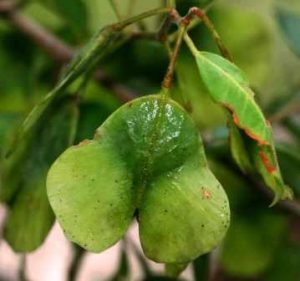
Hymenocardia acida. Photo: Bart Wursten. Source: Flora of Zimbabwe
Our slow progress prompted Linda to move us along a bit by 4- W.D. to a new patch where we saw the first of many Hymenocardia acida with their heart shaped fruits splitting vertically in two as we picked them. Another ride brought us to a stream where we were overwhelmed by the potato smell of Phyllanthus reticulatus full of fruit. This is such a familiar evening smell in Zimbabwe that it was satisfying to track it down.
Our lunchtime venue was under a truly enormous strangler Ficus sansibarica wherewe met with Sybil Duncanson and Caroline MacNaughtan who HAD walked to the river AND back to meet us. I doubt if any of us had ever seen a tree so laden with figs before; all on the main branches as in Ficus sur but on short stalks, with some branches so completely enveloped in fruit that no part of them was visible.
After lunch, and still moving river-wards, we explored the base of a large hill to discover Erythroxylum emarginatum and Teclea trichocarpa identified later at the herbarium by Bob Drummond, as was a specimen which we knew to be of the ANNONACEAE family, but which would not slot cleanly into place. It was Hexalobus sp., but we’re still not sure which one. Another member of the same family that we saw everywhere was Artabotrys brachypatelus with its distinctive grappling hooks to aid climbing (and identification . Further on, and more bafflement: PAIPILLIONOIDEAE pinnate leaves but berries instead of pods. Enlightenment came with the discovery of a single long pod with a quare seed “bump” and parallel lines; it was Xeroderris stuhlmannii, and on reading CP we learned that the fruit is often parasitized, hence the berries. Our next find was the Haxen family who had arrived that day and had been looking for us. No nonsense now; it was off in two vehicles to the river where we admired pot-holes and amazing formations sculpted in the rock like deep wave patterns in wet sand. Albizia tanganyicensis, Ficus abutilifolia and Afzelia quanzensis were added to the list, and while children played hide and seek among pot-holes the rest enjoyed a “cuppa” brewed up on a camping gas ring. Apart from a stop to re-examine the lunch time fig, it was straight back to the campsite where Andy prepared a large fire for the evening braai.
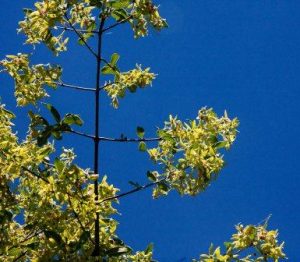
Lagynias dryadum. Photo: Bart Wursten. Source: Flora of Zimbabwe
The next morning found us exploring the nearby kopje to encounter Dalbergiella nyasae, Lagynias dryadum, Rothmannia fischeri and a fine peeling bark Commiphora marlothii with smooth, shining green trunk. Here were many more Vitellariopsis some with old fruit resembling miniature furry red gourds giving the common name for the tree of Gourd Milkwood. There was also Commiphora mollis and Sterculia quinqueloba and Ficus tettensis and – so much more. One oddity, great numbers of Euphorbia ingens on one small kopje and not more than a 100 yards away on another, a group of E.cooperi. Definitely a case of Campbells and McDonaldsl
As a final treat, on the drive way out from the farmhouse was an Entada abyssinica hung all over with long, rimmed pods which split up horizontally to release the seeded portions leaving the rims intact. Without the fruit it could easily have been dismissed as another Flamboyant in an avenue of them.
What a fantastic place; well worth another visit. Thank you to Linda for getting us out of Harare, and to Maureen for suggesting Mapor and arranging it, and to one and all who rallied round in the dark to help string up our tent on the first night – I had forgotten the tent pegs!
-FD
THE DAY OF THE CHABAUDII
Sunday 2lst of June 1992, during day light hours prior to the longest night of the year, the Tree Society gathered at the amphitheatre on Chedgelow Farn, as guests of John and Stella Danckwerts, who at the same time were entertaining a group of their friends. In social fashion we inter mingled and in consequence, our learner group enjoyed the company of a lot of new faces.
This gathering, predominantly Caucasian in origin, in a sylvan setting, on the eve of the northern summer solstice, might be thought by some to be celebrating a ritual derived from distant and druid forebears.
Maybe we were, but I do not think any maidens got themselves sacrificed to the rising sun. we did however enjoy a walk around delightful woodland, be-decked with massed Aloe chabandii in full flower. Come to think of it, this extravaganza in scarlet alone, might in some circumstances, be enough to launch a pagan festival.
As is our current procedure, Phillip led off the main group, and yours truly led the learners. We wandered through groves of large msasa and mountain acacia (Brachystegia spiciformis and B. glaucescens) me outcrops of granite forming an open glade environment, creating neatly spaced groups of trees, with bare rock and aloes in between. The herb layer here was dominated by the dwarf, Gardenia and Dicoma sp. showing both how stable is this environment, and how well the Dankwertz family have cared for this land.
How different from the sorry sight of so much of the land we see around the City where both sheet and gulley erosion are the rule, rather than exception.
In the afternoon while the main party went off southwards, a small group descended into the bed of Henry Hallam Dam. What a contrast, here we stamped around on almost moonscape environment, complemented by stagnant pools of water bearing blue green algae rather reminiscent of what the waters looked like when our planet was young, and there was still not much oxygen in the atmosphere.
In the words of the wise men of Zimbabwe we hoped that the next rainy season will be a good one and that the dams may fill. When that does happen, drowned will be the only specimen of Peltophorum africanum I saw this day. A nice little natural bonsai, 3 inches high, which has germinated below high water mark.
One of the draw backs of being chairman of our little society is that on an outing such as this, semi formal duties intervene and reduce the amount of time one can use to get down and scratch around on rock piles and termite heaps.
Accordingly, I was indebted to Maureen for showing me Cadaba termitaria in flower, so fragile and delicate. I had never seen this before.
As always a delightful day in delightful company. A place to return to and with this in mind your society has set up a sub-committee to determine when the time is right for us to commence rain dance formalities. We will then return to John and Stella’s amphitheatre to conduct the ceremony.
-Geroge Hall.
NYARUPINDA CATCHMENT
The Scene Temperature now is 6 degrees Celsius, no more swimming, but the Golden breasted bunting showed off its beautiful plumage as it splashed in the bird bath, we were delighted with its first visit to the garden.
Some corrections and improvements were necessary to last month’s Catchment, did you raise your eyebrows in disbelief when you read about a bream crossing the road – it was a BARBEL, whats more my companion leapt from his horse to run for the fish, he was too late.
The word waterlogged should have occurred in the paragraphs on vleis. An attractive vlei margin tree was forgotten, did you notice the absence of Combretum hereoense, mouse eared Combretum, this refers to the feel of the leaves.
CIVIT’S FOOD list should be ready to appear in next month’s Tree Life, all those different seeds in the spoor make it difficult to trace their origins.
Here are the groups of grasses put simply – just to glance at then as “about the woodlands you go”.
Timothy grasses (Setaria)
Paspelum grasses (Urochloa)
Love grasses (Eragrostis)
Thatchdng grasses (Hyparrhenia or their new name)
Spear grasses (Heteropogon)
Red topped Grasses (Rhynchelytrum or new name)
Pyramid grasses (Sporobolus, may be unexplained or expanded inflorescences)
Quake Grasses (Briza)
Couch grasses (Cynodon)
Finger grasses (Digitaria) have an inflorescence similar to Couch grasses
It is hoped that the experts agree with this list, its purpose is to make us look at grasses rather than dismiss them. Acacias are daunting until you get to know a few of then, it is the same with grasses.
That’s all this time.
-Benedicta Graves
GEORGE HALL CHAIRMAN


